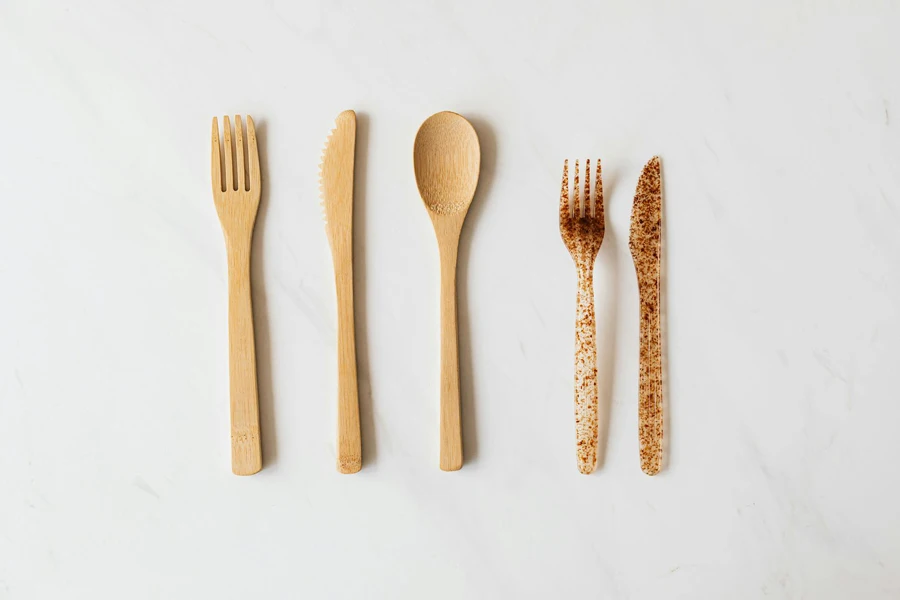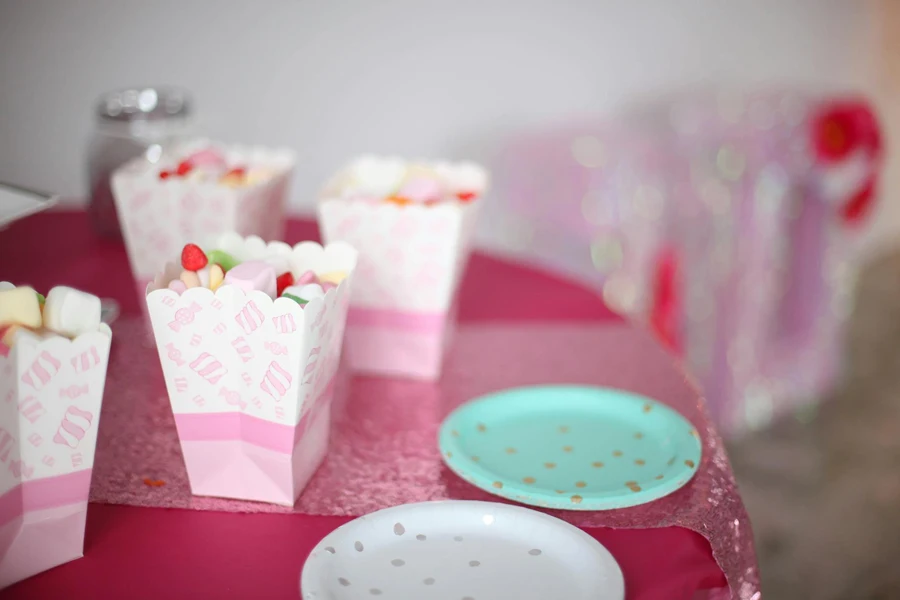Table of Contents
• Introduction
• Market overview
• Different types of disposable plates
• Things to consider when selecting products
• Conclusion
Introduction
Disposable plates are indispensable for events and businesses due to their convenience and hygiene benefits. The market for disposable plates is expanding rapidly, driven by innovations in materials and increasing demand from the food service industry. This article provides an in-depth analysis of the market, including the latest trends and market dynamics. It also examines various types of disposable plates and their features, helping businesses make informed choices. Key considerations for selecting the best disposable plates are outlined to ensure suitability for specific needs and environmental impact.
Market overview

Market scale and growth
The disposable plates market is experiencing significant growth, driven by increased demand from the food service industry and the rising popularity of food delivery services. The market size is expected to grow from US$ 5.12 billion in 2023 to US$ 9.35 billion by 2033, at a compound annual growth rate (CAGR) of 6.2%. According to market analysis, plastic plates held a dominant 62% share in 2022, followed by aluminum and paper plates. This trend is expected to continue, with plain designs leading in popularity and showing significant growth potential.
Regional insights and key drivers
Regional insights reveal that North America and the Asia Pacific regions are major contributors to the global market, collectively holding around 50% of the market share by 2027. The demand in these regions is fueled by the robust food service industries and a cultural shift towards convenient, on-the-go food consumption. Additionally, innovations in biodegradable materials are driving market growth, as consumers and businesses alike seek more sustainable options. The emphasis on hygiene and sanitation post-pandemic has also accelerated the adoption of disposable plates, replacing traditional reusable options in many settings.
Different types of disposable plates

Plastic plates
Plastic plates are made from a variety of materials, including Expanded Polystyrene (Foam), Polypropylene (PP), Polyethylene Terephthalate (PET), Polyethylene (PE), Polylactic Acid (PLA), and Polyhydroxyalkanoates (PHA). Expanded Polystyrene offers good insulation and is lightweight, making it ideal for hot and cold foods. Polypropylene plates are known for their high melting point, which makes them microwave-safe. PET plates provide clarity and rigidity, often used in upscale presentations. PLA and PHA are biodegradable options derived from renewable resources, gaining popularity due to their eco-friendly properties. Plastic plates are highly customizable in terms of shape, size, and color, making them versatile for various events.
Paper plates
Paper plates come in laminated and non-laminated forms. Laminated paper plates are coated with a thin layer of plastic or wax, enhancing their resistance to moisture and grease. This makes them suitable for serving foods with sauces or oils. Non-laminated paper plates are entirely compostable and biodegradable, breaking down naturally without leaving harmful residues. Paper plates are typically made from recycled paper or sustainably sourced virgin paper, contributing to their environmental appeal. They are lightweight and easy to dispose of, making them convenient for large gatherings and casual use.
Bagasse plates
Bagasse plates are manufactured from the fibrous residue left after extracting juice from sugarcane. This by-product is processed into a pulp and molded into plates that are robust and heat-resistant. Bagasse plates can withstand temperatures up to 200°F, making them suitable for hot foods and microwave use. They are also oil and water-resistant, providing a reliable option for both solid and liquid foods. Bagasse plates are fully compostable within 30 to 60 days in a commercial composting facility, making them an environmentally sustainable choice.
Bamboo plates
Bamboo plates are crafted from bamboo pulp, which is processed into a durable and strong material. Bamboo grows rapidly and does not require replanting, making it a highly renewable resource. The plates can handle heavy foods without bending or breaking and are naturally resistant to bacteria. Bamboo plates are often thicker than other disposable options, providing a premium feel. They are biodegradable and decompose within four to six months under composting conditions, minimizing environmental impact.
Palm leaf plates
Palm leaf plates are made from naturally fallen palm leaves that are collected, cleaned, and heat-pressed into shape. Each plate is unique due to the natural variations in the leaves, offering a rustic and aesthetic appeal. These plates are sturdy and can hold both hot and cold foods without leaking or breaking. They are microwave and oven-safe up to 350°F for 45 minutes. Palm leaf plates are compostable and biodegradable, breaking down within two months under composting conditions, contributing to a zero-waste lifestyle.
Cornstarch plates
Cornstarch plates are derived from corn-derived polylactic acid (PLA), which is processed into a compostable material. These plates are suitable for serving hot and cold foods, with a heat tolerance up to 110°F. Cornstarch plates decompose into water, carbon dioxide, and organic materials within six months in industrial composting facilities. They offer a sustainable alternative to conventional plastic plates, reducing reliance on petroleum-based products. Cornstarch plates are also free from harmful chemicals and toxins, making them safe for food contact and environmentally friendly.
Things to consider when selecting products

Event type
When selecting disposable plates for different types of events, the material and design play a crucial role. For formal events like weddings or corporate dinners, plates made from bamboo or palm leaf are recommended due to their sophisticated appearance and sturdy construction. Bamboo plates have a high tensile strength, making them resistant to breaking under heavy food loads. Palm leaf plates, pressed from naturally fallen leaves, provide a unique texture and are oven-safe up to 350°F, allowing for a range of food presentations. For casual events such as picnics or family gatherings, paper or plastic plates are more suitable. Paper plates, particularly those with a wax or plastic coating, offer resistance to grease and moisture, preventing leaks and maintaining structural integrity even with wet foods. High-density polyethylene (HDPE) plastic plates are lightweight yet durable, making them easy to transport and use in various outdoor settings.
Food type
The type of food being served is a significant factor in selecting the appropriate disposable plates. Heavy meals, such as those involving large portions of meat or dense side dishes, require plates with high load-bearing capacity. Bagasse plates, made from sugarcane fiber, are known for their robustness and can support weights of up to 1.5 kg without deformation. They also possess good thermal insulation properties, maintaining food temperature while being heat-resistant up to 200°F. For lighter snacks and appetizers, polystyrene foam plates are a practical choice due to their low thermal conductivity, which keeps cold foods cool and prevents condensation. These plates are typically designed with reinforced rims to enhance rigidity and prevent bending under lighter loads.
Environmental impact
Considering the environmental impact of disposable plates is increasingly important. Biodegradable plates, such as those made from PLA (polylactic acid) or PHA (polyhydroxyalkanoates), offer significant environmental benefits. PLA plates are derived from renewable resources like corn starch and have a decomposition rate of 90% within 180 days under industrial composting conditions. PHA plates, produced through bacterial fermentation of sugars, are fully biodegradable and can break down in both marine and soil environments, reducing plastic pollution. Additionally, certifications such as ASTM D6400 for compostability or the Biodegradable Products Institute (BPI) certification ensure that the plates meet stringent environmental standards, providing assurance of their eco-friendliness.
Plate sizes
Selecting the right size of disposable plates is essential for functionality and presentation. Standard sizes include 6-inch plates for appetizers and desserts, 8-10 inch plates for main courses, and 12-inch plates for buffet settings. Six-inch plates are ideal for serving hors d’oeuvres or small desserts and are designed to be easy to handle with one hand, facilitating mingling at events. Eight to ten-inch plates are versatile for serving main courses, offering sufficient space for portion control and food arrangement. They typically feature a weight capacity of up to 2 kg, making them suitable for substantial meals. Twelve-inch plates are preferred for buffets, providing ample space for multiple food items and reducing the need for multiple trips. These plates often come with compartmental designs to keep different food items separate, maintaining the integrity and flavor of each dish.
Conclusion

Selecting the right disposable plates requires careful consideration of the event type, the nature of the food being served, and the environmental impact of the materials used. The growing market offers a wide array of options, enabling businesses and consumers to make choices that effectively balance convenience, functionality, and sustainability. By evaluating these factors, it is possible to select disposable plates that not only meet practical needs but also align with environmental goals, supporting a move towards more eco-friendly practices in the industry.





 Afrikaans
Afrikaans አማርኛ
አማርኛ العربية
العربية বাংলা
বাংলা Nederlands
Nederlands English
English Français
Français Deutsch
Deutsch हिन्दी
हिन्दी Bahasa Indonesia
Bahasa Indonesia Italiano
Italiano 日本語
日本語 한국어
한국어 Bahasa Melayu
Bahasa Melayu മലയാളം
മലയാളം پښتو
پښتو فارسی
فارسی Polski
Polski Português
Português Русский
Русский Español
Español Kiswahili
Kiswahili ไทย
ไทย Türkçe
Türkçe اردو
اردو Tiếng Việt
Tiếng Việt isiXhosa
isiXhosa Zulu
Zulu